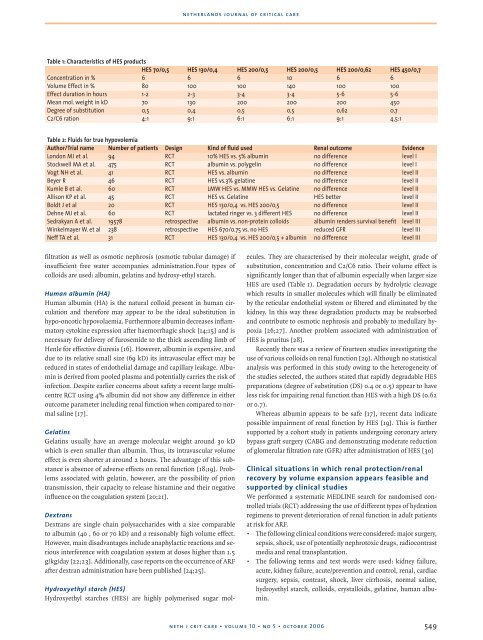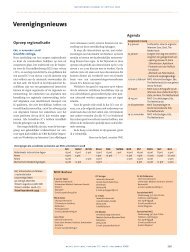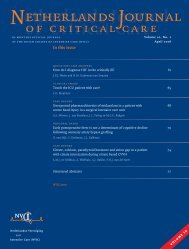Netherlands Journal
NJCC Volume 10, Oktober 2006
NJCC Volume 10, Oktober 2006
- No tags were found...
You also want an ePaper? Increase the reach of your titles
YUMPU automatically turns print PDFs into web optimized ePapers that Google loves.
netherlands journal of critical care<br />
Table 1: Characteristics of HES products<br />
HES 70/0,5 HES 130/0,4 HES 200/0,5 HES 200/0,5 HES 200/0,62 HES 450/0,7<br />
Concentration in % 6 6 6 10 6 6<br />
Volume Effect in % 80 100 100 140 100 100<br />
Effect duration in hours 1-2 2-3 3-4 3-4 5-6 5-6<br />
Mean mol. weight in kD 70 130 200 200 200 450<br />
Degree of substitution 0,5 0,4 0,5 0,5 0,62 0,7<br />
C2/C6 ration 4:1 9:1 6:1 6:1 9:1 4,5:1<br />
Table 2: Fluids for true hypovolemia<br />
Author/Trial name Number of patients Design Kind of fluid used Renal outcome Evidence<br />
London MJ et al. 94 RCT 10% HES vs. 5% albumin no difference level I<br />
Stockwell MA et al. 475 RCT albumin vs. polygelin no difference level I<br />
Vogt NH et al. 41 RCT HES vs. albumin no difference level II<br />
Beyer R 46 RCT HES vs.3% gelatine no difference level II<br />
Kumle B et al. 60 RCT LMW HES vs. MMW HES vs. Gelatine no difference level II<br />
Allison KP et al. 45 RCT HES vs. Gelatine HES better level II<br />
Boldt J et al 20 RCT HES 130/0,4 vs. HES 200/0,5 no difference level II<br />
Dehne MJ et al. 60 RCT lactated ringer vs. 3 different HES no difference level II<br />
Sedrakyan A et al. 19578 retrospective albumin vs. non-protein colloids albumin renders survival benefit level III<br />
Winkelmayer W. et al 238 retrospective HES 670/0.75 vs. no HES reduced GFR level III<br />
Neff TA et al. 31 RCT HES 130/0,4 vs. HES 200/0,5 + albumin no difference level III<br />
filtration as well as osmotic nephrosis (osmotic tubular damage) if<br />
insufficient free water accompanies administration.Four types of<br />
colloids are used: albumin, gelatins and hydroxy-ethyl starch.<br />
Human albumin (HA)<br />
Human albumin (HA) is the natural colloid present in human circulation<br />
and therefore may appear to be the ideal substitution in<br />
hypo-oncotic hypovolaemia. Furthermore albumin decreases inflammatory<br />
cytokine expression after haemorrhagic shock [14;15] and is<br />
necessary for delivery of furosemide to the thick ascending limb of<br />
Henle for effective diuresis [16]. However, albumin is expensive, and<br />
due to its relative small size (69 kD) its intravascular effect may be<br />
reduced in states of endothelial damage and capillary leakage. Albumin<br />
is derived from pooled plasma and potentially carries the risk of<br />
infection. Despite earlier concerns about safety a recent large multicentre<br />
RCT using 4% albumin did not show any difference in either<br />
outcome parameter including renal function when compared to normal<br />
saline [17].<br />
Gelatins<br />
Gelatins usually have an average molecular weight around 30 kD<br />
which is even smaller than albumin. Thus, its intravascular volume<br />
effect is even shorter at around 2 hours. The advantage of this substance<br />
is absence of adverse effects on renal function [18;19]. Problems<br />
associated with gelatin, however, are the possibility of prion<br />
transmission, their capacity to release histamine and their negative<br />
influence on the coagulation system [20;21].<br />
Dextrans<br />
Dextrans are single chain polysaccharides with a size comparable<br />
to albumin (40 , 60 or 70 kD) and a reasonably high volume effect.<br />
However, main disadvantages include anaphylactic reactions and serious<br />
interference with coagulation system at doses higher than 1.5<br />
g/kg/day [22;23]. Additionally, case reports on the occurrence of ARF<br />
after dextran administration have been published [24;25].<br />
Hydroxyethyl starch (HES)<br />
Hydroxyethyl starches (HES) are highly polymerised sugar molecules.<br />
They are characterised by their molecular weight, grade of<br />
substitution, concentration and C2/C6 ratio. Their volume effect is<br />
significantly longer than that of albumin especially when larger size<br />
HES are used (Table 1). Degradation occurs by hydrolytic cleavage<br />
which results in smaller molecules which will finally be eliminated<br />
by the reticular endothelial system or filtered and eliminated by the<br />
kidney. In this way these degradation products may be reabsorbed<br />
and contribute to osmotic nephrosis and probably to medullary hypoxia<br />
[26;27]. Another problem associated with administration of<br />
HES is pruritus [28].<br />
Recently there was a review of fourteen studies investigating the<br />
use of various colloids on renal function [29]. Although no statistical<br />
analysis was performed in this study owing to the heterogeneity of<br />
the studies selected, the authors stated that rapidly degradable HES<br />
preparations (degree of substitution (DS) 0.4 or 0.5) appear to have<br />
less risk for impairing renal function than HES with a high DS (0.62<br />
or 0.7).<br />
Whereas albumin appears to be safe [17], recent data indicate<br />
possible impairment of renal function by HES [19]. This is further<br />
supported by a cohort study in patients undergoing coronary artery<br />
bypass graft surgery (CABG and demonstrating moderate reduction<br />
of glomerular filtration rate (GFR) after administration of HES [30]<br />
Clinical situations in which renal protection/renal<br />
recovery by volume expansion appears feasible and<br />
supported by clinical studies<br />
We performed a systematic MEDLINE search for randomised controlled<br />
trials (RCT) addressing the use of different types of hydration<br />
regimens to prevent deterioration of renal function in adult patients<br />
at risk for ARF.<br />
• The following clinical conditions were considered: major surgery,<br />
sepsis, shock, use of potentially nephrotoxic drugs, radiocontrast<br />
media and renal transplantation.<br />
• The following terms and text words were used: kidney failure,<br />
acute, kidney failure, acute/prevention and control, renal, cardiac<br />
surgery, sepsis, contrast, shock, liver cirrhosis, normal saline,<br />
hydroyethyl starch, colloids, crystalloids, gelatine, human albumin.<br />
neth j crit care • volume 10 • no 5 • october 2006<br />
549







